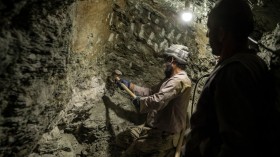For the first time, researchers have successfully simulated the pressure conditions in the Earth's lower mantle region in order to measure thermal conductivity using a new measurement technique on the mantle material magnesium oxide (MgO).
In doing so, the team, which included scientists from the Carnegie Institute and the University of Illinois, found the total heat transfer to be lower than previously believed at 10.4 terawatts, or 60 percent of the power used today by civilization.
Furthermore, the researchers determined that conductivity has less dependence on pressure conditions than predicted.
"The lower mantle sits on top of the core where pressures range from 230,000 to 1.3 million times the pressure at sea level," lead author of the study Douglas Dalton said, explaining that temperatures range from a hellish 2,800 degrees Fahrenheit to an even hotter 6,700 degrees Fahrenheit.
"The major constituents are oxides of magnesium, silicon and calcium," Dalton added. "Heat transfer occurs at a higher rate across materials of high thermal conductivity than across materials of low thermal conductivity, thus these low thermal conductivity oxides are insulating."
The study further marked the first time scientists were able to examine the effect of the disordered arrangement of the atom's of the major mantle's solid solutions on the way in which heat is conducted under such high pressures.
They did so by squeezing the samples between two diamond tips in an anvil cell and subsequently measuring the thermal conductivity of the samples. In all, they were able to go up to 600,000 times atmospheric pressure at room temperature.
"This technique allows us to measure the thermal properties of the material from the change in the reflectance of the material's surface, thus avoiding the need of contacting the material of interest as required by conventional techniques. We then compared the results to theoretical models," remarked co-author Alexander Goncharov.
Going forward, the scientists argue that their findings point toward a method that could be used to ultimately better understand the evolution of the Earth itself with the next step being examining the effects of different mineral components on the thermal conductivity, among other things.
"The results suggest that this technique could really advance other high pressure and temperature studies of the deep Earth and provide a better understanding of how Earth is evolving and how materials act under the intense conditions," Goncharov concluded.
© 2024 NatureWorldNews.com All rights reserved. Do not reproduce without permission.





